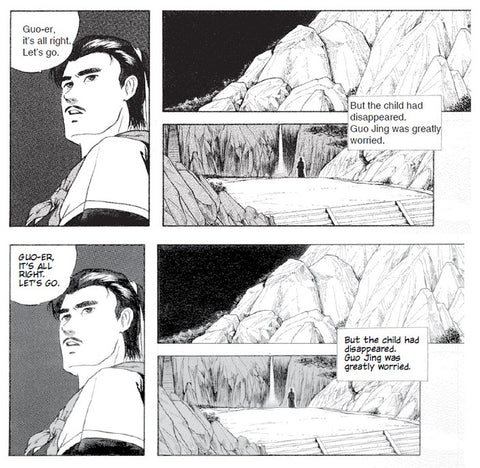An Insight into Editing Return of the Condor Heroes Manga

“The letter ‘I’ shouldn’t have crossbars. I sometimes get annoyed when I see a word in the middle of a sentence with the letter ‘I’ and it has crossbars. The crossbars should only appear when ‘I’ is used at the start of a sentence, like in ‘I am’ or ‘I will’.”
Such is a sentiment of Viency’s, an editor at Asiapac Books, towards proofreading speech bubble texts in comic books.
 Letter ‘I’ with and without crossbars, in a commonly-used comic book font
Letter ‘I’ with and without crossbars, in a commonly-used comic book font
Through her time spent with editorial work, Viency has developed a keen eye for such conventions that many of us may consider too miniscule and inconsequential to take note of in the everyday. Editorial work in the publishing industry is a highly meticulous and detail-oriented job; and more so for such an elaborate and content-heavy project like the Return of the Condor Heroes manga series. Just as the artist, Wee Tian Beng, plays a key role in creating works of art and visual images for a comic or graphic novel, she is tasked with bringing the artist’s vision to life by presenting the artwork in the most effective way possible, in order to reach out to the masses.
In general, Viency’s editorial tasks include proofreading, spell-checking, checking of artwork and visuals in the projects that she is involved in, as well as other administrative tasks such as copyright and front and back matters. Research and experimentation are important aspects to editorial work as well, for an editor to better visualise the outcomes of a project. The key challenge experienced in proofreading Return of the Condor Heroes was ensuring the consistency and accuracy of spelling and naming conventions, which was especially complex for a long full-length series with an exceptional number of pages.
For many comic and graphic novel projects, editorial staff may have slightly more engagement and intervention in their making processes, giving feedback and guidance to the artist at the beginning of the project, as well as at selected checkpoints and milestones throughout. However, in the case of the Return of the Condor Heroes manga, the editorial team drew most of their attention to the text, colour, and layout and presentation of the comic panels, since the artwork had been prepared and completed during its original 1997 manga serialisation. One notable change made to the Collector’s Edition of the manga was its choice of font. Fonts used in the older 1997 print publication did not fit with the contemporary comic book. In order for the new edition to be elevated and kept up to date with current popular manga, all its texts had to be changed to a style that readers are comfortable and familiar with.
 A panel from the old versus new edition of Return of the Condor Heroes manga
A panel from the old versus new edition of Return of the Condor Heroes manga
There are many stereotypes and public assumptions about editorial work. The most common one encountered by Viency points to that of editors being too heavy-handed in the creation process of comics. As such, one of her goals as an editor is to debunk such a myth in the making of Return of the Condor Heroes. For Viency, there is no single or concrete methodology in the creating and editing of comics, or any work of art, and she works towards maintaining that the integrity of Wee’s artwork is maintained during the editorial process. Editorial work largely encompasses collaboration between the editors, publisher, and artists, and much of it is process-driven, relying on dialogue between all parties. After all, the common goal is to produce a piece of work that one can be proud of and can be enjoyed by a wide audience.
